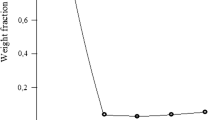Abstract
Rare earth elements are essential for modern life products and green technologies. Recent supply constraints have boosted the development of rare earth projects after the price peak of 2011. The feasibility of a project depends on the definition of a processing route, which in turn depends primarily on the rare earth mineral, with monazite and bastnaesite representing the two most relevant minerals. Monazite-type ores usually contain high acid consumption impurities, such as iron, aluminum, calcium, magnesium, and phosphates, and may also contain prohibitive levels of radioactive thorium in its composition. This work presents a thermodynamic analysis of a monazite system and discusses the fundamentals of a selective process route for rare earth extraction from monazite ores with high iron content. This process involves sulfation by means of concentrated sulfuric acid and roasting at a high temperature. The route yields high rare earth extraction with low iron and thorium extractions and low acid consumption. Rare earth extractions as high as 80% were achieved, while iron and thorium extractions were lower than 1%, and acid consumption was lower than 0.34 kg of sulfuric acid per kg of ore. The operational window was compared to the one predicted by thermodynamic modeling, with 700 °C representing the optimal roasting temperature.







Similar content being viewed by others
References
Lucas J, Lucas P, Le Mercier T, Rollat A, Davenport WGI (2014) Rare earth: science, technology, production and use, 1st edn. Elsevier, Amsterdam
Lehmann B (2014) Economic geology of rare earth elements in 2014: a global perspective. European Geologist 37:21–24
Gupta CK, Krishnamurthy N (2005) Extractive metallurgy of rare earths. CRC Press, Boca Raton
U.S Geological Survey (2016) Mineral commodity summary, Reston, Virginia, USA
SNL/S&P Global, Historical prices (2017) www.snl.com. Accessed 8 July 2018
Pradip, Fuerstenau DW (1991) The role of inorganic and organic reagents in the flotation separation of rare-earth ores. Int J Miner Process 32:1–22
Zhang J, Zhao B, Schereiner B (2016) Separation hydrometallurgy of rare earth elements. Springer, Basel
Merritt RR (1990) High temperature methods for processing monazite: reaction with calcium chloride and calcium carbonate. J Less-Common Met 166:197–210
Renou A, Tognet J (2003) Procede de traitement d’un minerai de terres rares a teneur elevee en fer, FR2 826 667 – A1, France
Huang X, Li H, Long Z, Liu Y, Zhao N, Zhang G (2009) A process of smelting monazite rare earth ore Rich in Fe, WO2009/021389
Mackowski SJ, Raiter R, Soldenhoff KH, Ho EM (2009) Recovery of rare earth elements, US2009/0272230 A1
Boudreault R, Primeau D, Fournier J, Simoneau R, Garcia MC, Krivanec H, Dittrich C (2012) Process for recovering rare earth elements from various ores, EP 3141621A1
Berni TV, Pereira AC, Mendes FD, Tude AL (2013) System and method for rare earth extraction. Patent US 2013/0336856 A1
Teixeira LAV, Silva RG (2015) System and process for selective rare earth extraction with sulphur recovery. Patent US 2015/0329940 A1
Onal MAR, Borra CR, Guo M, Blanpain B (2015) Recycling of NdFeB magnets using sulfation, selective roasting and water leaching. J Sustain Metall 1:199–215
Verbaan N, Bradley K, Brown J, Mackie S (2015) A review of hydrometallurgical flowsheets considered in current REE projects, In: Simandl GJ, Neetz M (eds) Symposium on strategic and critical materials proceedings. British Columbia Ministry of Energy and Mines, British Columbia Geological Survey Paper 2015-3, Victoria, British Columbia, pp 147–162
Testa FG, Avelar AN, Silva RG, Souza CC (2016) Mineralogical characterization and alternative to concentrate the rare earth lithotypes from alcaline complex of Catalão – GO. Associação Brasileira de Metalurgia, Materiais e Mineração, São Paulo. https://doi.org/10.4322/2176-1523.1064
HSC Chemistry (2015) Equilibrium calculations. Outotec, Pori
Brod JA, Gibson SA, Thompson RN, Junqueira-Brod TC, Seer HJ, Moraes LC, Boaventura GR (2000) Kamafugite affinity of the Tapira alkaline-carbonatite complex (Minas Gerais, Brazil). Rev Bras Geosci 30:404–408
Ribeiro CC (2008) Geology, Geometallurgy, controls and genesis of phosphorus deposits, rare earths and titanium of the Catalão carbonate complex I, Goias. Dr. Thesis, Universidade de Brasília (in portuguese)
Bainbridge DW (1973) Sulfation of a nickeferous laterite. Mater Trans 4(7):1655–1658
Wendlandt WW, George TD (1961) A differential thermal analysis study of the dehydration of the rare-earth (iii) sulphate hydrates. The heats of dehydration. J Inorg Nucl Chem 19:245–250
Nathans MW, Wendlandt WW (1962) The thermal decomposition of the rare-earth sulphates. J Inorg Nucl Chem 24:869–879
Lowell PS, Schwitzgebel K, Parsons TB, Sladek KJ (1970) Selection of metals oxides for removing SO2 from fuel gas. I&DC Research Results Service, ACS, Washington, DC
Poston JA Jr, Siriwardane RV, Fisher EP, Miltz AL (2003) Thermal decomposition of the rare earth sulfates of cerium (III), cerium (IV), lanthanum (III) and samarium (III). Appl Surf Sci 214:83–102
Hwdwgus AJ, Fukker K (1956) Ver. Gluhlampen-u. Elektrizitats-werke, A.-G., Tungsram, Budapest. Z Anorg Allg Chem 284:20–30
Francisco EAB, Prochnow LI, Toledo MCM, Ferrari VC, Jesus SL (2007) Thermal treatment of aluminous phosphates of the crandallite group and its effect on phosphorus solubility. Sci Agric, (Piracicaba, Brazil) 64(3):269–274. https://doi.org/10.1590/S0103-90162007000300009
Acknowledgments
The authors would like to thank Vale S.A., especially Cassia Souza, Keila Gonçalves and Patrice Mazzoni for sample, material support, and the permission for publishing the results of this investigation. The authors are also thankful to Wagner Soares, Luzia Chaves, and Vale—CDM technicians, for their support in this work. V Ciminelli and D Majuste acknowledge the support from CNPq—Conselho Nacional de Desenvolvimento Científico e Tecnológico, CAPES—Coordenação de Aperfeiçoamento de Pessoal de Nível Superior—Brasil—Finance Code 001, and FAPEMIG—Fundação de Amparo à Pesquisa de Minas Gerais.
Author information
Authors and Affiliations
Corresponding author
Ethics declarations
Conflict of Interest
The authors declare that they have no conflict of interest.
Rights and permissions
About this article
Cite this article
Teixeira, L.A.V., Silva, R.G., Avelar, A. et al. Selective Extraction of Rare Earth Elements from Monazite Ores with High Iron Content. Mining, Metallurgy & Exploration 36, 235–244 (2019). https://doi.org/10.1007/s42461-018-0035-5
Received:
Accepted:
Published:
Issue Date:
DOI: https://doi.org/10.1007/s42461-018-0035-5




